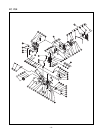
- 10 -
English
C) Start the engine. (Refer to the Engine Manual
accompanying this unit.)
D) When the engine has run for 1-2 minutes, flip toggle
back to the original position.
The operation of this compressor is automatic and is
controlled by the pilot valve which idles it when the pressure
in the air-tank reaches the maximum level and restart it
when the air pressure drops during use to the restart level.
The pilot valve is preset by the manufacturer and must not
be modified in any way.
WARNING: If you notice any unusual noise or vibration, stop
this compressor.
2. Adjustment of working pressure
The air pressure coming from the air tank is controlled by
the regulator knob (Fig. 5). Turn the pressure regulation
knob clockwise to increase discharge pressure, and
counterclockwise to decrease discharge pressure.
The outlet pressure gauge indicates the air pressure
available at the outlet side of the regulator. This pressure
is controlled by the regulator and is always less or equal
to the air tank pressure.
The air tank pressure gauge indicates the reserve air
pressure in the air tank(s).
When adjusting the pressure, check and make sure that
a pressure gauge for the tank has the pressure level that
is higher than that of the pressure to be adjusted.
It is also imperative that you make adjustment by slowly
starting up the pressure from the level that is lower than the
pressure to be adjusted.
WARNING: Check the manufacturer’s maximum pressure
rating for nailers, staplers and accessories.
Compressor outlet pressure must be regulated
so as to never exceed the maximum pressure
rating of the nailers, staplers and accessories.
3. Shutdown
A) To stop this compressor, move the engine switch to
the “Off” position. (Refer to the Engine Manual
accompanying this unit.)
B) Gradually open the drain cock, take out the drainage
and all the compressed air inside the tank to prevent
any internal corrosion of the tank. (Fig. 6)
WARNING: When the tank gets corroded, there is a
risk of breakdown. Accordingly, be sure
to discharge the drain inside the tank
after each use.
The drain contains moisture in the air,
abrasion particles, rust, etc. To
discharge the drain, therefore, gradually
open the drain cock, and be careful not
to point it at your face or eye.
C) Allow this compressor to cool down.
D) Wipe this compressor clean and store in a safe, non-
freezing area.
WARNING: Always stop the engine and pull out the
spark plug cap to prevent any sudden start
of the engine and remove this compressed
air from the air tank before performing the
maintenance operations.
Read the instruction manual before performing
maintenance. The following procedures must be
performed when stopping this compressor for
maintenance or service.
A) Turn off this compressor.
B) Disconnect spark plug wire from engine.
C) Open all drains.
D) Wait for this compressor to cool down before starting
service.
MAINTENANCE
Fig. 5
Fig. 6
Tank
Drain cock
Increase: Clockwise
Decrease:
Counter clockwise
Knob of
pressure
regulator
Joint of regulator
mounting bracket
Outlet pressure gauge
Tank
pressure gauge


















